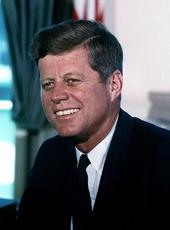[ Released March 25, 1963. Dated March 21, 1963 ]
Dear Mr. LaFarge:
It was very kind of you to write me in support of the Youth Employment Act and the National Service Corps. As you know, I have sent a message to the Congress, asking for favorable action on these proposals at an early date.
The operations of the Youth Conservation Corps and the National Service Corps will be nationwide in scope. The organizations will draw their membership from many communities and will function in many states. I am very pleased that the Indian tribes as well as citizens interested in Indian welfare have fully recognized the benefits which Indian reservation areas can obtain from these programs.
To the extent that the new proposals apply to and benefit the first Americans, they are, as you have pointed out, further steps in carrying out the Indian program outlined in my letter to you of October 28, 1960. I am pleased to note, and I am sure you are too, that we have moved along quite a distance on the road which we set out to travel. In addition to the benefits which Indian communities, along with other localities, are realizing under the Area Redevelopment Act, much has been done through the Bureau of Indian Affairs to stimulate greater human development and fuller economic development on Indian reservations.
In the field of education, for example, funds have been provided during the past two years to build classrooms and dormitories that will accommodate an additional 7,000 Indian students. Last year 4,500 Indian young people attended colleges and other post-high school institutions and more than $1.5 million is now available to provide scholarship aid for such students. About $700,000 is being provided by 36 tribal organizations and $650,000 by the Bureau of Indian Affairs.
The Indian Bureau's vocational training program for those from 18 to 35 is now helping about twice as many young Indians as it was two years ago; 1,400 are now enrolled in such courses as compared with 700 in 1961. By June the number will rise to 1,500.
On the economic development side, more than 1,000 Indians are now working in 27 plants which have been established over the past several years on or near reservations as a result of the Indian Bureau's industrial development program. They make up about
75 percent of the work force in these plants and have achieved an excellent reputation for skill, especially in operations requiring eye-hand coordination and small muscle movements.
Under the Accelerated Public Works Program $12 million has been made available for 88 projects in Indian reservations in 19 states. At the end of February 3,600 Indians were employed on these projects.
Jobs for Indians on the reservations have also been increased substantially by the Bureau's policy of shifting as much of its construction work as possible to force account. In the 18 months ending last December the Bureau added nearly 1,400 Indians to its force account payrolls, bringing the total number so employed over 3,000. This year nearly $30 million is going for force account work--more than twice the total in 1961. In addition, over 7,000 Indians are employed on the Bureau's regular staff at installations throughout the country; their combined annual salaries total over $35 million.
To provide greater financing for Indian economic enterprises on the reservations, the authorization for the Bureau's revolving credit fund has been increased by $ 10 million to a total of $27 million. Bureau loans totaling $25 million have been extended to 142 tribal enterprises and the tribes have committed to these enterprises an additional $14 million.
The need for better housing on Indian reservations is, as you know, tremendous but a good start has been made on the road to improvement. After 25 years of the low-rent housing program, the first units to be built on an Indian reservation--50 units on the Pine Ridge Reservation in South Dakota-are now under roof and 10 are already occupied. About 40 other reservations have shown interest in such housing.
Perhaps even more promising for Indian reservations is the self-help program of housing improvement on which the Bureau of Indian Affairs and the Public Housing Administration are jointly working. The first project, involving 50 family units on the San Carlos Reservation in Arizona, has just been approved and widespread interest in self-help possibilities is being shown on other reservations.
Finally steps were taken to establish a close working relationship between the Federal Government and the Indian tribes through the appointment to positions in the Interior Department of such good friends of the Indian people as Stewart Udall, John Carver and Philleo Nash.
The mere enactment of a new law, the mere initiation of a new program does not of itself bring about all desired results. A close working relationship between the civil servants on the one hand and the recipients of the service on the other is necessary for our programs to take hold and result in the betterment of living conditions on our Indian Reservations. For that reason we look forward to continued effective cooperation with the Indian tribes and the citizen organizations and church groups interested in Indian welfare.
Sincerely,
JOHN F. KENNEDY
[Mr. Oliver LaFarge, President, Association on American Indian Affairs, 647 College Street, Santa Fe, New Mexico]
Note: Mr. LaFarge's letter, dated February 5, was released with the President's reply.
The President's letter of October 28, 1960, is published in "The Speeches of Senator John F. Kennedy, Presidential Campaign of 1960" (S. Rept. 994, pt. I, p. 800, 87th Cong., 1st sess.).
John F. Kennedy, Letter to the President of the Association on American Indian Affairs. Online by Gerhard Peters and John T. Woolley, The American Presidency Project https://www.presidency.ucsb.edu/node/237109

